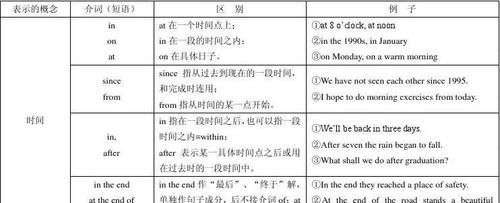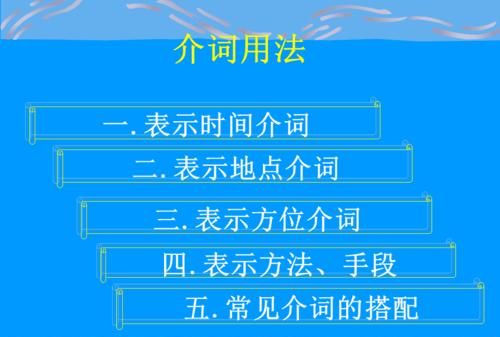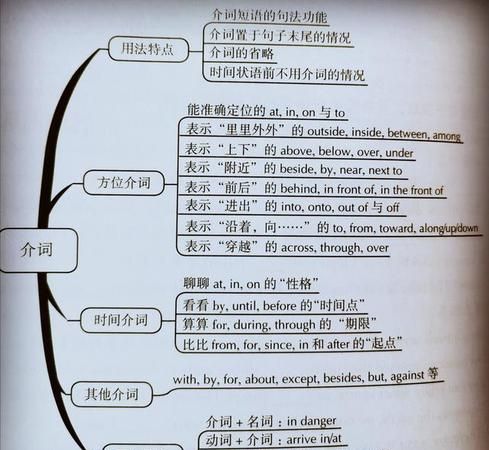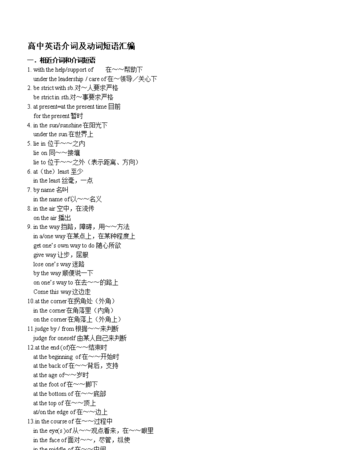本文目录
英语介词知识点的归纳总结
介词又叫前置词,一般放在名词的前面。介词是一种虚词,一般不重读,不能在句中独立充当一个成分,它只是表示它后面的名词、代词或相当于名词的词、 短语 或从句与 其它 成分的关系。下面我给大家分享一些英语介词知识点,希望能够帮助大家,欢迎阅读!
英语介词知识点1
介词的分类
介词可按其结构分为:
1. 简单介词:简单介词是由一个单词构成的介词。分为普通介词(如:at,by,for,in,over,to,up 等),合成介词(如:as for,onto,into,within,without,out of 等),和分词介词(如:concluding,regarding,concerning 等)三种。
2. 二重介词:二重介词是由两个简单介词重叠使用构成的。如:from among,since before,until after,except in 等。
3. 短语介词:介词是由两个或者两个以上的词所组成的短语构成的。一般说来,这个短语的最后一个词是简单介词。如:according to,because of,instead of,in front of,with reference to 等。
介词还可按其词义分为下列几种:
1. 表示地点。如:about,across,after,among,around,behind,below,beside,beyond,down,from,into,off,over,throughout,towards,up,within,without 等。
2. 表示时间。如:about,after,around,as,at,before,behind,between,by,during,for,from,in,into,of,on,over,past,since,through,till(until),to,towards,within 等。
3. 表示除去。如:besides,but,except 等。
4. 表示比较。如:as,like,above,over 等。
5. 表示反对。如:against,with 等。
6. 表示原因、目的。如:for,with,from 等。
7. 表示结果。如:to,with,without 等。
8. 表示手段、方式。如:by,in,with 等。
9. 表示所属。如:of,with 等。
10. 表示条件。如:on,without,considering 等。
11. 表示让步。如:despite,in spite of,notwithstanding 等。
12. 表示关于。如:about,concerning,regarding,with regard to,as for,as to 等。
13. 表示对于。如:to,for,over,at,with 等。
14. 表示根据。如:on,according to 等。
15. 表示其他。如:for(赞成),without(没有)等。
英语介词知识点2
介词短语在句中的作用
介词后面的名词、代词或相当于名词的词、短语或从句叫介词宾语,有时也可以叫介词补足语。可做介词宾语的词语主要有:名词或名词性从句、代词、数词、动名词或动名词短语以及由连接代词(副)词引导的从句或不定式短语。
介词和介词宾语一起构成介词短语。
介词短语在句中可作:
1. 定语。如:
China is a country with a long history.
中国是历史悠久的国家。
2. 表语。如:
You must remain in bed.
你必须卧床休息。
3. 补足语。如:
I found everything in good condition.
我发现一切状况良好。
4. 状语。如:
We put the play on in a theatre.(地点状语)
我们在剧院上演这部戏。
In spite of the heavy rain, they arrived.(让步状语)
尽管雨下得很大,他们还是到了。
5. 作主语。如:
From Shenyang to Dalian is four hours' drive.
从沈阳到大连开车要4个小时。
6. 作宾语。如:
The three thieves served a sentence of between 4 and 6 years.
三个盗窃犯服刑 4 到 6 年。
英语介词知识点3
常用介词的基本用法
介词在英语中的使用很广泛,也是高考中的重点,正确使用介词是很重要的,下面归类讲述一些重点介词的用法:
(一)时间介词:
1. in
A. 表示世纪、年代、年、月、季节、星期等较长的时间。
如: in 1999,in January,in the week
B. 表示每天的上午、下午、晚上。
如: in the morning/afternoon/evening
C. in 后接一段时间的名词,表示“过多久以后”, 常用于将来时的句中。 in 有时表“在……之内(within)”。
如:I’ll come and see you again in five days.
过五天后,我再来看你。
D. in + n. 表时间,相当于 during。
如:in the war/storm 等。
2. on
A. 某(几)天
如: on Sundays,on May 1st 等。
B.某天的上午、下午、晚上。
如:on Monday morning,on Christmas Eve 等。
C.on + doing 表示“一……就……”。
如: On entering the room she saw him.
她一进屋就看见了他。
3. at
A. 表小时或分钟。
如: at ten to nine(九点差十分)。
B. 后接特定的时间名词。
如: dawn(黎明),daybreak(天亮),night,mid-night,noon 等。
C. 表用餐时间。
如: at breakfast/supper/lunch 等。
D. 表年龄。
如: at the age of… 等。
E.还有 at this/that time 等。
(二)方式介词:
1. by
A. 后接 ing 分词
B. by hand 用手,手工;by letter 用写信的 方法 ;by post 由邮局传递;by electricity 用电
C. divide by 用……除;learn by heart 背下,记住
D. by land/air/water/sea/boat/ship/car/bus/train/taxi/rail(way)/plane 等。
E.by means of…(用/靠……的方法);by way of…(取道于,经由,用……的方法)。
2. with
A. 后接表示工具的名词,多有“手拿着”之意。
如:He struck me with a whip.
B. 后接人体的器官。
如:You can lift a big piece of bamboo with one hand.
C.后接表示情绪、态度的名词。
如:He looked at them with great satisfaction.
3. through
如:Our country has sent and received TV programmes through man-made satellite.
B. 后接名词,说明行为者的经历。
如:Those who learn not only from books but also through practice will succeed.
C. 后接透过、穿过的物体,说明行为者所依靠的途径。
如:He was looking through a telescope.
4. on
A. 后接表示食物的名词表示所依靠的食物。
如:All ants live on liquid food.
B. 接支撑身体的部位。
如:I knelt on one knee over him.
C. 接表示大型交通工具的名词,名词前有相应修饰语。
如: on the NO.1 bus,on this ship
5. in
A. 后接表示情绪或精神状态的名词。
如:in silence,in tears,in surprise
B. 表示与语言文字有关的方式。
如:in word,in English
C. 接表示具体的小型交通工具名词。
如:in my car,in that boat,in his plane
D. 与 way,order,hurry 等连用。
如:in this way,in order,in a hurry
E. 后接表示包裹用品名词。
如:She wrapped him with a blanket.
(三)双重介词的用法:两个介词的表意角度不同,前者比较笼统,后者比较具体,前者需要后者补充。
如:There were five matchsticks in between the two pages.
He has travelled everywhere but in his own country.
The strong wind from off the coast now whipped the house.
We have seen that the hibernating animal reduced movement to far below the ordinary level.
(四)but 的用法:
A. 表示“除去……之外”、“只不过”之义。在很多情况下可与 except 互换,只是 but多用在代词后面。
如: I have written all my lessons but one.
B. 一般只接动词不定式作宾语,不接 ing 分词作宾语,当 but 之前含有 do 时,but后的不定式要省 to。
如: Then it has no choice but to lie down and sleep.
C. cannot but,could not but,cannot choose but,could not choose but,cannot help but,could not help but 为特殊句式后接动词原形,表示“只得”、“不得不”。
如: I could not choose but go.
D. never… but 表示“除非”、“若不”。
如: I never go past that house but I think of my miserable life in the old times.
E. but for = if it were not/had not been for 用于虚拟语气中表示“要不是”。
如: But for his advice we should fail.
F. 可连接两个主语。介词后边的代词要用宾语。 句子 前的谓语要与 but 前的主语一致。
如: Nobody but me knows it.
(五)against 的用法:
1. 逆着、迎着(方向)。
如: We run against the wind.
2. 反对。
如: He was active in politics and was strongly against slavery.
3. 撞击;碰着。
如: He hit against the pole reading as he was walking.
4. 靠着。
如: He put the ladder against the wall.
5. 和……对照;与……对比;以……为背景。
如: Red flags stand out brightly against the blue sky.
6. 防备。
如: defend against enemy, protest against rain
英语介词知识点的归纳相关 文章 :
★ 初中英语介词知识点:常用介词要点
★ 英语高中语法介词知识点汇总
★ 英语语法介词语法知识点
★ 小学一年级英语介词的知识点
★ 英语的地点方向介词汇总知识点
★ 初中英语介词知识点:时间介词
★ 初中英语介词语法知识点讲解练习
★ 初中英语介词用法大全
★ 小学英语重点知识点总结归纳
★ 2020年高考最新的关于高考英语介词知识点精析

高中英语介词知识点归纳
介词的英语全称为“preposition”是由“前缀pre-(在……前部)+position(位置)”构成的,所以又叫前置词。一般放在名词、代词或动名词的前面。接下来我给大家分享关于高中英语介词知识,希望对大家有所帮助!
高中英语介词知识1
表时间的介词:about, around, before, by, at, after, in, on, between, during, for, from, since, till, until, within等。
1.表示时间先后的before,after和in。
before表示某一时刻之前和after表示某一时刻之后。in一般表示“从现在或说话时刻算起某一段时间之后”,用于将来时。after则表示以过去为起点的某一段时间之后,用于过去时。“in+时间段"也可作”在……之内"解。
He will be back in a few days. 他几天之后就回来。
He left on Monday and returned after three days. 他星期一走的,三天后回来的。
It's difficult to draw a horse well in half an hour.半小时之内画好一匹马是困难的。
2.表示"时间延续"的for, from...to
for表示动作或状态延续的时间长度,谓语动词必须是延续性的。而from...to...表示“从……到……”。
We have studied English for three years. 我们学英语已三年了。
My family lived in Beijing from 1996 to 1999.我家从1996年到1999年住在北京。
3.表示"时限"的介词since, from, by, until(till)
since表示动作的起始点,其意是 "从……以来 ",常与完成时态连用。
from表示时间的起始点,其意是"从",常和一般过去时连用。
until(prep. & conj.)意为"直到……为止"。
by (Prep.) 表示"到……为止"、"不迟于……"的意思。与be动词连用时多用于一般式;与行为动词连用时,多用于完成式。侧重于某动作将在将来或将来某一刻之前发生。
Your son will be all right by supper time. 你儿子到晚饭前就会好的。
I have lived in Beijing since 1996. 自1996年以来我就居住在北京。
From then on I began to learn English. 从那时起我就开始学英语了。
Let's wait until the rain stops. 让我们等到雨停。
He didn't go home until he had finished his homework.(用于否定句) 他直到完成他的家庭作业才回家。
注意:
(1)用在肯定句中,主要动词一般是延续性的,表示这个动词的动作一直延续到till(until)所表示的时间为止。英汉互译时,语序基本一致。
(2)用在否定句中,主要动词一般是终止性的,表示这个动词的动作直到 till(until)所表示的时间才发生。译为“(直)到时……才”。
We won't go until we get it back again. 直到我们再找回来才能走。
They travel until they come to a wild part of the forest. 他们在森林中行进,遇到一块荒地就停下来。
till(prep.& conj)和until的用法基本一样,可 以互换。放在句首一般用until不用till。在口语中,英国用till,美国多用until。
You'd better stay in bed till tomorrow. 你最好呆在床上直到明天为止。
注意:not until用在 句子 开头时主谓要倒装(在主句中进行倒装)。
Not until noon did it stop raining. 直到中午雨才停。
not...until...的强调句型为:It is/was not until...that...
It was not until he finished his homework that he went to bed.
直到完成作业,他才去睡觉。
4.表示“时间”的介词at,in和on。
at多用于钟点时刻前,所表时间大多比较短暂。at还可用于习惯表达法。例如:at breakfast/lunch/supper/dinner等。
in常用于上午、下午、晚上及表示季节、月份、年份等名词前,所指时间可长可短的时间段。on用于特殊的日期或某日的上午、下午或晚上等。试比较:
They'll have a meeting at nine in the morning. 他们将在上午九点钟开会。
Do you often do some washing on Sunday? 你常在星期天洗衣服吗?
高中英语介词知识2
表地点的介词:about, at, in, on, over, through, across, along, around, before, between, beyond, by, down, to, toward, under, up, within, near等。
1. at,on和in。
at一般是指比较小的地点和某种活动场所,或把一个地方看作一个点(不涉及大小)。
如:at the school gate, at the second crossing, at the bus stop, at the top of the paper, at the cinema, at 103 Wall Street, at the traffic lights。
on表示某东西在一个平面上(包括竖着的平面)。或某东西接触或接近一条线或类似一条线的东西(如河流、道路、边界等)如:
on the floor/ground/table/chair, on the wall, on the moon, on my head, on page seven,on a small river, on the road,on my way to school。
in 要表示在某一区域或某一立体空间。如:
in a country/city/town/village/garden/park/zoo,in the room/house/building/box, in the sky, in the sea, in the sun, in the middle of the days
2.above; over; on。
On/beneath和over/under都表示在某一物体上。但前者强调两物相接触,而后者强调覆盖这一物体。 over表示在某人或某物的正上方, 反义词 是under。above表示位置高于某人或某物,但不一定是正上方,反义词 below。below和above都可用来表示高于(higher than)。如果要表示覆盖或越过时,则用over。指数量时,我们一般用over(=more than)表示超过;但如果指上下垂直的度量及海拔高度时,要用above。
There's a picture on the wall. 墙上有一幅画。
A wide and busy road which was built like a bridge over another road fell onto the one below/ above.一座立交桥上部宽阔而车辆川流不息的马路坍塌至桥下的路上。
The water came up over/above our knees. 水已涨至我们膝盖之上。
The temperature will stay above zero in the day-time. 白天温度将保持在零度以上。
3.表示"里外"的介词in/out of,inside/outside。
表示静止的位置:in和out of相对应;表示动态时,into和out of相对应。inside,outside可以表示静止的位置,意为"在里/外面",也可表示"到里/外面"。
He is in the classroom. 他在教室里。
They walked into the garden. 他们走进花园 。
They walked out of the garden. 他们走出花园 。
He was standing outside/inside the door. 他正站在门的外面/里面。
4.表示"在……旁边"的介词by,beside。
by和beside同义,但by比beside常用。
One day a little monkey was playing in a tall tree by the river.
一天,一只小猴子在河边的一棵大树上玩。
Is there a big tree beside the house? 在房子旁有棵大树吗?
5.表示"在……中间"的介词词组in the centre of和in the middle of。
in the centre of:表示"中心"、"中央"的意思,指某种有确定边缘或形状的东西的中心点。除可指圆、球体或方形的中心外,还可以用于借喻,表示重要活动或事物的中心。
in the middle of:在表示"中间"的意思时,指跟两边或各边,两端或各端等距离的部分,还可以指时间方面的"中间"或表示程度的"中间"。
There was a terrible big fire last year in the centre of the city.
去年,市中心发生了一场可怕的大火。
I am in the middle of the great forest in South America.
我现在是在南美洲这个大森林的中部。
6.表示"沿着"的介词up,down,along。
up表示"沿着而上";down表示"沿着而下",另外,进城用up;出城用down。along表示"沿着",即从一端到另一端。
The boy jumped quickly up the tree. 男孩很快地爬上了树。
We went down the hill before sunset. 我们在日落之前下了山。
We walked along the river. 我们沿着河走。
7.表示"前、后"的介词before,in front of,in the front of。
在现代英语中,我们一般不用before这个介词来表示地点,而用in front of。
There is a car parked right in front of our gate, and we can't get out!
一辆小汽车正好停在我丫山门口,我们都出不去了。
在以下几种情况下,也可用来指地点:
(1)谈到次序的排列(如名单等):
Your name comes before mine. 你的名字在我前头。
(2)表示"在(某重要人物)面前":
I came up before the magistrates for dangerous driving last week.
上星期我因开车冒险而被法院传坏,
(3)用于right my eyes,before my very eyes(在我面前公开地)等词组中。
in front of表示"在(某一物体)前面",而in the front of表示"在……范围内的前部"。
He likes sitting in the front of the car. 他坐车总喜欢坐在前面。
8.表示"方位"的介词in,to,on。
in表示在某一地域之内的某方位(属于该范围);to表示在某一地域地区之外的某方位(不属于该范围);on表示与某地相邻的关系。这三个词表达位置关系恰似数学中圆的"包含(in)、相离(to),相切(on)关系"。
Taiwan is in the southeast of China. 台湾位于申国东南部。
England lies to the west of France. 英国位于法国的西面。
Hunan is on the east of Guizhou. 湖南在贵州的东面。
高中英语介词知识3
表手段的介词:by, with, in
三者均可表示"用"、"以"的意思,但用法不同。
by后常接动名词,表示以某种 方法 做某事;in后接名词,表示以某种工具或某物做某事;除用来与way构成in this/that/a...way表示用方法外,一般多与一些抽象化了的名词搭配,表示用某种方式、语言、风格等。
Learn to swim by swimming. 在 游泳 中学习游泳。
True friendship can not be bought with money. 真正的友谊是无法用金钱买到的。
You shouldn't have treated the matter in the wrong way.
你不该用错误的方式来对待这件事。
An English teacher should try to teach in English. 英语教师应尽量用英语教学。
It's impolite to write a letter in red. 用红笔写信是不礼貌的。
高中英语介词知识4
表原因的介词:for, from, of, with等。
1.at, for, with
三个词均可组成介词 短语 ,表示行为或状态原因、动机或理由。at常于表示感情色彩的动词形容词或过去分词搭配,后接表示具体事物的名词。for和with后接表示感情的抽象名词,其中with侧重于随着心理变化而发生的感情变化。如:
I was angry at what he said.
He was very surprised at the news.
His face turned red with anger.
We bought this house with a much higher price than others just for its convenience.
我们买下这幢房子花的钱比 其它 房屋要贵得多,就是图的方便。
2. because of, due to, thanks to
because of通常位于句首或句尾,作状语;due to通常作表语;thanks to多用于句首。
He eats because of greed, not hunger.他不是因为饿了,而是因为贪嘴才吃的。
Our thanks are due to him. 我们要感谢他。
Thanks to John , we won the game. 多亏约翰,我们才赢了这场比赛。
高中英语介词知识5
表比较的介词:as, like, over, above等。
两者都可 以表示"像……"as作连词,引导比较状语从句;从句中的动词或整个谓语部分往往可以省略。as和like都可作介词,译为"像……一样",但有区别:as侧重同一性,强调属同一类或完全相似;like侧重于比较,是比喻,并不意味着同一类或完全相似。
Then I made faces jumped like a monkey.接着我做鬼脸,并像猴子一样跳来跳去。
She spoke of me as her dearest friend.她谈起我就像我是她最亲密的朋友似的。
试比较:
Let me speak to you as a father. 让我作为一个父亲在同你讲话。
Let me speak to you like a father. 让我像一位父亲那样同你讲话。
高中英语介词知识点相关 文章 :
★ 英语高中语法介词知识点汇总
★ 高中英语知识点总结大全
★ 高中英语知识点
★ 高中英语知识点
★ 高中英语语法知识点
★ 高中英语知识点汇总
★ 高中英语的知识点归纳
★ 高中英语语法知识点整理总结
★ 高中必备英语知识点归纳
★ 高中英语知识点总结与归纳

高一英语常用介词有哪些
(一)表示时间的介词:
1.at, on, in
(1) at表示“在某一时刻、某一时点”
at 5:30 在5:30 at sunrise 日出时 at lunch 午饭时
at noon 正午时 at night 夜间
I get up at 6:00 every day. 我每天6:00起床。
表示“在……岁”时用at the age of…。
如:at the age of five.在五岁时。
(2) on表示“在具体某一天或某天的上、下午”。如:
on Monday在星期一 on April 1st在四月一日
I heard a shot on the morning of March 18.三月十八日早晨我听到一声枪响。
泛指上、下午、晚上、夜间时用in the morning/afternoon/evening, at night;但若指具体某一天的上述时段时,则一律用on。
如:On the afternoon of May 23.在五月二十三日下午。
(3) in表示“在某月、季节、年、世纪”以及泛指的上、下午、晚上。
in September 在九月 in winter 在冬季
in 1999 在1999年 in the 20th century 在20世纪
in the morning/afternoon/evening 在上午/下午/晚上
2.for, during, through
(1) for表示“一段时间”,后接与数词连用的时间名词。多与完成时连用。
I’ve been a soldier for 5 years.我入伍已5年了。
She has been ill for several days. 她已经病了几天了。
表示“持续一段时间”时,for后面必须跟“数字+时间名词”,而during后决不可接数字。
(2) during表示“在……期间”
He visited many nice places during his stay here.在他逗留期间他参观了许多美丽的地方。
What did you do during the summer vacation? 你在暑假做了什么?
(3) through表示“一直……,自始至终”
They worked hard through the winter.整个冬天他们都在努力工作。
She treated me like her brother through these years. 这些年来她始终把我当哥哥对待。
3.from, since
(1) from表示“等时间的起点”,作“从……”解,多用于“from…to/till…”中。
You can come anytime from Monday to Friday.周一至周五你什幺时间来都行。
The exam will start from 9:00am. 考试将从上午九点开始。
①from“从……(开始)”未必持续到现在,如:
from 1995 to 1998.从1995年到1998年。
而since是指“自从……以来一直持续到现在”
②since一般只与现在完成时连用,而from不受此限。
(2) since表示“自从……以来(直到现在)”
He has been away from home since 1973.他自从1973年就离开了家乡。
We have known each other since ten years ago.我们十年前就认识了。
for与since表示一段时间,但for与时间段连用,而since与时间点连用。
如for two hours(持续)两小时;since last week自从上周直到现在
4.before, by, till, until
(1) before指“在……之前”
Please come before ten o’clock.请10点以前来。
The meeting will end after 3:00pm. 会议将在下午三点后结束。
表示“在……以前”时,before与by基本可通用。但by还有“截至……为止”之意,此时可与完成时连用,而before一般不与完成时连用。如:
How many models have you made by the end of last month?
截至上月底你做了多少个模型?
(2) by指“不迟于,到……时为止,在……以前”
I must finish my homework by lunch.午饭前我必须做完作业。
We had learned over 1000 words by the end of last term.
到上学期末为止,我们已经学了1000多个单词了。
(3) tell (until) “直到……为止”
You must wait for him till tomorrow.你必须一直等到他明天。
He didn’t come back until twelve o’clock last night.他昨晚下到12点才回来。
在肯定句中,till (until)必须与延续动词连用。若与点动词连用,till (until)只能用于否定句中。
5.after, in, within
①after表示“在……之后”,是before的反义词。
We’ll hold a party after dinner.晚餐后我们将举办晚会。
He got a cancer and died after a year.他患了癌症,一年后去世了。
I’ll phone you after 1 arrive.到达后我给你打电话。(after作连词)
②within“在……时间之内”
I can finish it with an hour.我不需一小时就可把它做完。
比 较 after与in
①after后可跟时间段,也可跟时间点,如after school(放学后),
而in后必须跟一段时间,如in an hour(一小时后)。
②after既可用于将来时,也可用于过去时,而in只能用于将来时。
③after既可作介词,又可作连词,而in只能作介词②in“在……时间之后”
I’ll arrive in an hour.我一小时后到达。
in与within后都必须跟时间段。
(二)表示“地点、方向”的介词:
1.in outside between, among
①in表示“在……里面”,如:
What’s in the box? 盒子里是什么?
She put her book in the desk. 她把书放进了书桌。
②outside指“在……外面”
There are many people outside the room.房间外有很多人。
What did your see outside the hall? 你在大厅外看见了什么?
③between在……之间(指二者)
There is a hospital between the hotel and the post office.在宾馆与邮局之间有所医院。
The building stands between the park and the small river. 那栋建筑位于公园和小河之间。
between是指“在两者之间”,而among指“在多个之间”。
④among在……之间(指三者以上)
“There is a thief among you.” The policeman shouted to the crowd.
警察向人群喊道:“你们中间有个小偷!”
He found his place among the crowd. 他在人群中找到了他的位置。
2.on, above, over, below, under
(1) on在……上面,表面相互接触。
There is an apple on the table. 桌上有一个苹果。
On the top of the hill, there is a flag. 山顶有一面旗子。
(2) above只表示“在……上方或位置高出……”,与below相对。
A plane flew above our heads.一架飞机从我们头上飞过。
The Turners live above us. 特纳一家人住在我们的上面。
(3) over“在……正上方”,与under相对。
There is a bridge over the river.河上有一座桥。
The picture is hanging over the blackboard. 那张图挂在黑板的正上方。
(4) below在……下方,低于……
There are many flowers below the window.窗下有很多花。
Her skirt reaches just below her knees.她的裙子刚到膝盖下。
(5) under在……正下方
They sat under a big tree, drinking.他们坐在一棵大树下喝酒。
What are you wearing under your coat? 你外套里面穿了什么?
3.near, by, beside
(1) near在……附近,与far相对
A hospital was built near the railway station.在火车站附近建了一所医院。
My hone is near he school. 我的家离学校很近。
(2) by = beside,靠近,在……旁边,比near距离更近
He just sat by/ beside me in the cinema.在电影院他就坐在我旁边。
He lay down beside the statuary. 他在雕像旁躺下了。
4.in front of, behind, around
(1) in front of在……前面
A river flows in front of the house.房子前有一条河
They put a bunch of flowers in front of the door. 他们在门前放了一束花。
in the front of表示“在……前部”,指里面。
There is a red chair in the front of the room.在房间前半部有把红椅子。
(2) behind在……后面
A high building stands behind the village.村子后面有一高层建筑。
The cat lies behind the door. 猫躺在门后面。
(3) around在……周围,围绕
There are many trees around the villege.村子周围有很多树围绕。
There are flowers around the stage. 舞台周围摆着鲜花。
5.from, to, for, into, out of
(1) from从……
The train started from Paris.火车发自巴黎。
She will fly from Beijing to Hongkong. 她将从北京飞往香港。
(2) to到……(目的地)去,向……
He went to Germany last year.他去年去了德国。
They got to the town very late. 他们很晚才到那个镇。
(3) for向……,表目的方向
He left for Tianjin on business yesterday.他昨天出差去天津了。
The train for Shanghai has been away. 去往上海的火车已经开走了。
towards, to和for都可表示“向……”,其区别如下:
①towards仅指朝向某个方向,不一定是目的地,而 to和for都是“向目的地”。
②for作“向(目的地)”时,常用于固定搭配中,如:leave for; start for
(4) into进入
Please put the water into the bottle.请把水倒入瓶子里。
The teacher came into the classroom with a smile. 老师微笑着走进了教室。
(5) out of从……出来
A beautiful girl in red went out of the shop.一个穿红衣服的漂亮女孩从商店里走了出来。
They pulled him out of the water. 他们把他从水里拉了出来。
6.along, across, through
(1) along沿着
He likes to drive along the river.他喜欢沿着河开车。
There are all kinds of beautiful flowers along the road street. 沿街有着各种美丽的花。
(2) across横穿
The little girl is afraid to go across the street.这个小女孩不敢横穿马路。
It’s dangerous to run across the busy road. 跑着穿越繁忙的马路是很危险的。
(3) through穿过
It took us ten minutes to drive through the tunnel.开车穿过这条隧道花了我们10分钟时间。
He pushed his way through the crowd to the platform. 他从人群里挤到了站台。
7.at, in
二者都表示“在某个地方”,但at多指较小的地方,如车站、家等,而in多指在“大地方”,如城市、国家、大洲等。(但大小有时也是相对的)。
He lives at No.27 Zhongshan street in Nanjing.他住在南京市中山路27号。
The plane will arrive in Beijing at 13:00. 飞机将于13点到达北京。
三、其它用途的介词:
1. 表示“标准或单位”的介词:at, for, by
(1) at表示“以……速度”“以……价格”
He drove at a speed of 80 miles an hour.他以每小时8英里的速度行驶。
I sold my car at a high price.我以高价出售了我的汽车。
(2) for用……交换
I bought it for 20 dollars.买它花了我20美元。
How much for these apples? 这些苹果多少钱?
at与for都表示价格,但at表示“单价”,for表示总价,at后一般跟“price”这个词,而for后只能跟总钱数。
如:I bought it at a low price.我买它的价格很低。
I bought it at the price of $80 a pound.我以每磅80美元的价格买的它。
I sold it for $10.我10美元把它卖掉了。
(3) by以……计,后跟度量单位
Gold is sold by the gram.金以克出售。
They paid him by the month.他们按月给他计酬。
2.表示“材料”的介词:of, from, in
(1) of表示从成品仍可看出原料。
This box is made of paper.这个盒子是纸做的。
This salad is made of apples and strwberres. 这种沙拉是由苹果和草莓做的。
(2) from表示从成品已看不出原料。
Bread is made from wheat.面包是小麦做的。
The lifeboat is made from some special material. 这个救生艇是由某种特殊材料制成的。
(3) in用……材料。 常用write, speak, talk, answer等连用。
Please fill in the form in pencil first.请先用铅笔填写这个表格。
They talk in English.他们用英语交谈。
in指材料时,材料前不用冠词。
比较:用铅笔画
3.表示“工具或手段”的介词:by, with, on
(1) by凭借“工具或手段(多用于交通工具)如: by bus乘公共汽车,by plane乘飞机
He usually goes to work by bike.他通常骑车去上班。
He sent the news to me by e-mail.他通过电子邮件发给了我这一消息。
表示搭乘交通工具时,既可用by,又可用in,区别在于用by时,表示交通工具的名词前不能加冠词,而用in时名词前必须加冠词。
(2) with用……工具
He broke the window with a stone.他用石头把玻
He stopped the ball with his right foot.他用脚把球停住。
with表示“用……工具”时,工具前必须加冠词或物主代词。
(3) on以……方式。多用于固定词组。
They talked on the telephone.他们通过电话进行交谈。
She learns English on the radio/on TV.她通过收音机/电视学英语。
4.表示“关于”的介词:of, about, on
(1) of仅指“关于”人或事物的存在,如:
He spoke of the film the other day.他前几天提到了这部影片。
He thought of this matter yesterday.他昨天想到了这件事。
He thought about this matter yesterday.他昨天考虑了这件事。
(2) about指“关于”某人或某事物的较详细的情况。
It’s a book for children about Africa and its people.
它是一本供儿童阅读的关于非洲和非洲人的书。
Can you tell me something about yourself? 你能告诉我一些关于你自己的事情吗?
(3) on是指“关于”学术性的或严肃的,供专门研究用的。
It’s a textbook on the history of China.它是一本有关中国历史的教科书。
5.表示“原因、理由”的介词:for, at, from, of, with
(1) for表示“一般的理由”常与famous, punish等词连用。
Xi’an is famous for its long history.西安因历史悠久而著名。
The city is well known for her large population. 这座城市以人口众多而知名。
(2) at一般指“情感”的原因,通常放在表示“惊讶或喜悦等感情”的动词或形容词之后,表示“因听到或看到而……”。
She got angry at his words.她因为他的话生气了。
He was surprised at the news.听到这消息他大吃一惊。
(3) from表示“外在的原因”。如受伤、车祸等。
He died from the wound.他因受伤而致死。
Her son was badly hurt in a traffic accident. 她儿子在一次车祸中严重受伤。
(4) of表示“内在的原因”,如病、饿等到。
He died of cancer.他死于癌症。
The old man died of hunger.老人死于饥饿。
(5) with表示“由外在影响到肉体或心理”的原因。
He shook with cold.他因寒冷而发抖。
He shouted loudly with anger. 他气得大喊大叫。
6.like, as
(1) like像……一样(其实不是)
The little tiger looks like a cat.这只小老虎看起来像只猫。
The mooncakes are like the moon. 月饼像月亮。
(2) as作为,以……身份(其实是)
He was hanged as a spy.他被作为间谍绞死了。
He talk to me as a father.他以父亲的身份跟我谈话。
7.against, for
against反对,与for是反义词,如:
Are you for my idea or against it? 你赞同还是反对我的想法?
They fought against the enemy. 他们抗击敌人。
8.besides, except都表示“除了”。besides的用法就等于as well as。
He is interested in tennis besides(as well as)football. 除了足球,他还对网球感兴趣。
(1)besides是包括后面所提人或物在内的“除了”,可以理解为“除之外…还、除之外…又”,表示两部分的相似性。
Twenty-five students went to the cinema besides him.
除他以外,还有25个学生去看了电影。(他和另外25人都去了)
We like biology besides English.除了英语外,我们还喜欢生物。(生物和英语都喜欢)
(2)except是指不包括后面所提人或物在内的“除了”,可以理解为“撇开…不谈”,表示两部分的不同。
Everyone is excited except me.除我以外的每个人都很激动。(他们激动,而我却不激动)
All the visitors are Japanese except him.
除他以外的所有游客都是日本人。(其他人是日本人,可他不是)
介词的省略
在以下几种情况中,介词常常省略。
1.当表示时间的词前有this, that, next, last, every, each, some, any, all等时,介词应省略。
We watched an exciting football match last week.(last week前不能用介词in等)
上周我们看了一场激动人心的足球赛。
Come any day you like. 你想哪天来哪天来。
Come on any day you like.(×)
next前可以加冠词,但意义不同。
next week下周(以现在为起点)
the next week第二周(以过去某时为起点)
2.表示时间的名词前有不定冠词,且不定冠词作“每一……”解时,前面不用介词,如:
每小时80英里。
80 miles in an hour.(×)
80 miles an hour.()
An apple a day keeps the doctor away.每天吃一个苹果,医生不找我。
3.含有way的短语。如:in the same way, in this/that way, in another way等用于句末时,in常省略。
She did it the same way.她用同样的方法做的。

英语常用介词的用法归纳
1.表示地点位置的介词
1)at ,in, on, to,for
at (1)表示在小地方; (2)表示“在……附近,旁边”
in (1)表示 在大地方; (2)表示“在…范围之内”。
on 表示毗邻,接壤,“在……上面”。
to 表示在……范围外,不强调是否接壤;或“到……”
2)above, over, on 在……上
above 指在……上方,不强调是否垂直,与 below相对;
over指垂直的上方,与under相对,但over与物体有一定的空间,不直接接触。
on表示某物体上面并与之接触。
The bird is flying above my head.
There is a bridge over the river.
He put his watch on the desk.
3)below, under 在……下面
under表示在…正下方
below表示在……下,不一定在正下方
There is a cat under the table.
Please write your name below the line.
4)in front [frant]of, in the front of在……前面
in front of…意思是“在……前面”,指甲物在乙物之前,两者互不包括;其反义词是behind(在……的后面)。
There are some flowers in front of the house.(房子前面有些花卉。)
in the front of 意思是“在…..的前部”,即甲物在乙物的内部.反义词是at the back of…(在……范围内的后部)。
There is a blackboard in the front of our classroom.
我们的教室前边有一块黑板。
Our teacher stands in the front of the classroom.
我们的老师站在教室前.(老师在教室里)
5)beside,behind
beside 表示在……旁边
behind 表示在……后面
编辑本段2.表示时间的介词
1)in , on,at 在……时
in表示较长时间,如世纪、朝代、时代、年、季节、月及一般(非特指)的早、中、晚等。
如 in the 20th century, in the 1950s, in 1989, in summer, in January, in the morning, in one’s life , in one’s thirties等。
on表示具体某一天及其早、中、晚。
如on May 1st, on Monday, on New Year’s Day, on a cold night in January, on a fine morning, on Sunday afternoon等。
at表示某一时刻或较短暂的时间,或泛指圣诞节,复活节等。
如at 3:20, at this time of year, at the beginning of, at the end of …, at the age of …, at Christmas, at night, at noon, at this moment等。
注意:在last, next, this, that, some, every 等词之前一律不用介词。如:We meet every day.
2)in, after 在……之后
“in +段时间”表示将来的一段时间以后;
“after+段时间”表示过去的一段时间以后;
“after+将来的时间点”表示将来的某一时刻以后。
3)from, since 自从……
from仅说明什么时候开始,不说明某动作或情况持续多久;
since表示某动作或情况持续至说话时刻,通常与完成时连用。since表示"自(某具体时间)以来",常用作完成时态谓语
的时间状语。
since liberation(1980)自从解放(1980年)以来 They have been close friends since childhood.
他们从小就是好朋友。 (1)since the war是指"自从战争结束以来",若指"自从战争开始以来",须说"since
the beginning of the war"。
(2)不要将since与after混淆。
比较:He has worked here since 1965.(指一段时间,强调时间段)自从1965年以来,他一直在这儿工作。
He began to work here after 1965.
(指一点时间,强调时间点)从1965年以后,他开始在这儿工作。
4)after, behind 在……之后
after主要用于表示时间;
behind主要用于表示位置。
时间名词前介词用法口诀
年前周前要用in
具体日子要用on
遇到几号也用on
上午下午得是in
要说某日上下午
用on换in记清楚
午夜黄昏用at
黎明用它也不错
at用在时分前
说“差”可要用上to
说"过''要用past
编辑本段3.表示运动方向的介词:
across, through 通过,穿过
across表示横过,即从物体表面通过,与on有关,为二维
through穿过,即从物体内部穿过,与in有关,为三维。
编辑本段4.表示“在……之间”的介词:
表示“在……之间”的介词在英语中属于方位介词,如in front of ,behind ,on, in, near, under, up
between, among
between指在两个人或两个事物之间;
among指在三个或三个以上的人或事物之间。
编辑本段5.表示其他意义的介词
1)on ,about 关于
on 表示这本书,这篇文章或演说是严肃的,或学术性的,可供专门研究这一问题的人阅读;
about表示内容较为普通,不那么正式。
2)by, with, in 表示方法、手段、工具
by 以……方法、手段或泛指某种交通工具;
with 表示用 …工具、手段,一般接具体的工具和手段;
in 表示用…方式,用…语言(语调、笔墨、颜色)等;
3)except, besides 除了
except 除……之外,不包括在内;
besides 除……之外,包括在内。
Except for Mr. Wang, we went to see the film.(王先生没去)
Besides Mr. Wang, we also went to see the film.(王先生也去了)
27)near 靠近....。
There are some flowers near the house.
房子附近有一些花。
28)of ...的,属于...。
This is a map of China.
这是一张中国地图。
29)off 离开...,在...之外。
The young man got off the train quickly.
那个年青人很快下了火车。
I live in a village a little way off the main road.
我住在离大路不远的一个村庄里。
30)on 在...之上。
My book is on the table.
我的书在桌子上。
31)out of 从...出来,在...之外。
The dog run out of the house.
狗从房子里跑出来。
32)outside ... 外边.
They are waiting outside the gate.
他们在门外等着。
33)over 在...之上,遍于...之上,越过...。
There is a light over the desk.
桌子上方有盏灯。
He is over sixty years old.
他有六十多岁。
34)past 越过...,过...,超越...。
The students walked past the post office.
学生们走过了邮局。
It is ten past two.
现在是两点十分。
35)round 围着...,绕过...,在...周围。
We sat round the table.
我们围着桌子坐下。
The earth goes round the sun.
地球绕着太阳转。
36)since 自... 以后,自...以来。
He has made great progress in English since he came into the college.
从他来到大学后,他的英语有了很大进步。
37)through 经过...,穿过...。(立体层面)
They went through the forest.
他们穿过了森林。
38)throughout 遍及...,在各处。
The police searched for the criminal throughout the mountain.
警察搜山寻找犯人。
39)till 直到...,在...以前。
He didn't come back till eleven o'clock.
他直到十一点钟才回来。
We'll be home till six.
六点以前我们都会在家。
40)to 到...,向...,趋于。
How long is it from here to the station?
从这儿到车站有多远?
41)under 在...之下,低于。
There are some footballs under the bed.
床底下有几颗足球。
These students are under seventeen years old.
这些学生们不到十七岁。
42)until 直到,在...以前,
Please wait for us until we come back.
请等着我们回来。
It was not until last week that I handed in mathematics paper.
直到上周,我才交了数学论文。
43)up 在...上面,在...上。
He went up the stairs.
他上了楼梯。
44)upon 在...之上,迫近...。
It's not polite to look down upon him.
蔑视他是不礼貌的。
45)within 在...之内。
You must finish the work within two weeks.
你必须两周内完成这项工作。
46)without 没有,不,在...之外。
We can't do it better without your help.
没有你的帮助,我们就做不好。
We couldn't live without air and water.
没有空气和水,我们就不可能生存。
动词与介词(或副词)的搭配
add…to 加到……上 agree with 同意(某人)
arrive at(in) 到达 ask for 询问
begin…with 从……开始 believe in 相信
break into 闯入 break off 打断
break out 爆发 bring down 降低
bring in 引进 bring up 教育,培养
build up 建起 burn down 烧光
call back 回电话 call for 要求约请
call in 召来 call on 拜访 访问
care for 喜欢 carry on 继续开展
carry out 实行开展 check out 查明 结帐
clear up 整理,收拾 come about 发生,产生
come across (偶然)遇见 come out 出来
come to 共计 达到 compare…with 与……比较
compare to 比作 cut off 切断
date from 始于 depend on 依靠
devote to 献于 die out 灭亡
divide up 分配 dream of 梦想
fall off 下降 fall over 跌倒
feed on 以……为食 get down to 专心于
get through 通过 give in 让步,屈服
希望采纳

以上就是关于高中英语介词用法总结,英语介词知识点的归纳总结的全部内容,以及高中英语介词用法总结 的相关内容,希望能够帮到您。
